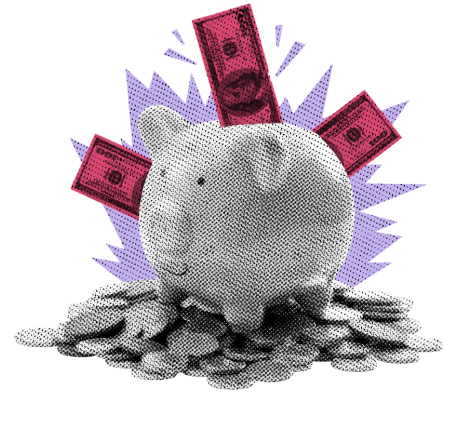
Stocks gained on Friday, after Producer Prices signaled that Supply-based inflation is in good shape. Earnings season started with an appetizer; a taste of what we can expect… or rather, hope for in the week ahead with banks leading the earnings procession.
It’s complicated. Those nasty banks, taking advantage of us when interest rates are high. That was a joke. Banks are not nasty; without them you probably wouldn’t have been able to buy your house… or your car. As you might know, banks can’t simply charge you whatever interest rate they want. There are market pressures that ensure that you are paying somewhere in the neighborhood of what everyone else is paying. They are subject to the rates market. The rate market exists because there are many banks vying for your business. If one bank is asking for an interest rate far over the market, borrowers would not borrow from it and seek out better terms elsewhere. Now, the process is more complex than that, but at the end of the day, all banks are subject to prevailing interest rates, and interest rates, as you have probably heard, are controlled by the Federal Reserve.
So, the theory goes, when the Fed raises interest rates to throttle back on economic growth, banks charge higher rates which makes borrowing more expensive. Because borrowing is more expensive, we consumers along with companies, who also borrow from banks, will spend less money, and lower demand will allow inflation to ease – at least that’s the plan. That said, the Fed called that play in 2022 and 2023. Whether it worked or not is still up for debate, but the reality is that borrowing costs have gone up significantly since the period prior to that where interest rates were near or at historical lows. The S&P500 Bank Index has had a bumpy journey since the start of the pandemic, returning -16.8%, +32.3%, -21.56%, and +7.05% in 2020 through 2023 respectively. That’s enough to get one seasick. This year, year to date, things have been pretty exciting with the group earning some +25% so far. I am sure that many are wondering if the run can continue now that the Fed has committed to lowering interest rates once again. After all, banks make money by lending money, and lower interest rates means that banks should be making less revenue, right? Well, er, that is not exactly accurate, it actually… depends.
I am bringing up this today because this week will feature many bank earnings announcements. Last Friday, banking giant JPMorgan Chase announced its Q3 earnings beating EPS and Revenue projections by +9% and +3.4% respectively, and the stock gained +4.44% in Friday’s session. The daily gain isn’t surprising given the beat, right? But was it the beat alone? Probably not, it was HOW the company beat that was important. You see, the company managed to earn $23.54 billion in net interest margin, when analysts were expecting +$22.8 billion. Let’s start with that. Net Interest Margin (NIM) is the difference between the interest a bank earns from lending and the interest it pays on the funds it uses to make those loans. For example, if a bank borrows money at 2% and lends it at 3%, it will earn a 1% margin on the loan for as long as the loan is outstanding. Think about that statement. How does a bank get funds to lend out? Well, for the most part, it gets money from deposits, for which it pays a short-term interest rate. The bank is technically borrowing money from depositors. If it can effectively borrow for less than what it can charge loans, a bank is doing a good job.
There is a theme emerging here. Borrow cheaply in short term and lend at higher rates long term. An example would be banks borrowing money from you in short-term CDs and lending out the money for 30-year mortgages. For this to work, the yield curve needs to be upward facing, and the steeper the better, theoretically. But the yield curve has been flat to inverted for a long period of time. That would make conditions for large NIM very challenging despite the high Fed Funds rate. The following chart shows the yield curve this morning. Check it out and follow me to the close.

You can see on this chart that 1 through 6-month yields are roughly between 4.5% and 4.8%, and 10-year yields are around 4.1%. Short term CDs (Certificates of Deposit) are based on the left-hand side of the curve, while mortgage rates are based on the right-hand side of the curve. I just checked bankrate.com and Barclays is offering 5% API for a 6-month CD. That is, Barclays will borrow money from you for 6 months and will pay around 2.5%. Banks can lend money for 30-years at 7%, which is the average US Mortgage rate this morning. If Barclays can pull it off, it can make +4.5% over the next 6 months borrowing from CDs and lending in mortgages. Of course, there is a catch. Barclays must return the money to CD holders in 6 months, and it has already lent out the money for the next 30 years. It will have to borrow money to pay off the initial CD. No problem. But what if CD rates go higher? That means… its Net Interest Margin for the transaction will be less. BUT WAIT! Fed Funds are only going lower, and with it, shorter-term yields, which means that banks can possibly make higher NIM as it continues to ride the market. With mortgage rates higher than they have been on average for the past 10-years, all those mortgages issued in the past few years stand to return solid NIM over the coming months.
If all goes as planned, the Fed will continue to lower rates in the coming months. Simultaneously, as the economy heals, recovers, and flourishes, longer yields will go higher. The yield curve will steepen, and new loans issued by banks could have even higher NIMs. Now, of course, it isn’t this simple and not at all this easy. However, as a general rule of thumb, one would expect loan margins to increase going forward. That said, it will become a critical item to watch for this week’s bank earnings. How did they do last quarter and how well do they expect to do in coming quarters. JPMorgan Chase, in its Friday announcement, increased its prior full-year NIM guidance to $92.5 billion from $91 billion. Perhaps THAT is what got investors excited!
To be clear, there are many other ways diversified, large banks make money besides NIM, but it is core to their business models and is often the first thing assessed in an announcement. Banks also make money in trading, investment banking fees, and wealth management fees. In volatile times the first and second can produce larger returns, while the third does well in a growing market. With markets on the climb and volatility at moderate levels, we will expect solid revenues to come from these profit centers. Finally, with banks, expense management is always critical, especially at larger ones and super-regional ones. So, in a nutshell, in the days ahead, pay close attention to what reporting banks are saying about NIM expectations and trends, FICC trading revenues, investment banking fees and their trends, growth in wealth management AUM, deposit rates, loan demand, and finally, expense management. ALSO, as you can see, pay close attention to the shape, or rather the slope of the yield curve. In coming days, we will hear from PNC Financial, Bank of America, Citigroup, Citizens Financial, KeyCorp, M&T Bank, Truist, Huntington Bancshares, and Ally Financial to name just a few of the banks whose success will be judged on all these factors, but Net Interest Margin will likely be the first thing discussed, and now you know how it all works… basically speaking, or course.
FRIDAY’S MARKETS

NEXT UP
- No economic releases this morning, but in the days ahead, in addition to earnings, we will get regional Fed reports, housing numbers, Retail Sales, and Industrial Production. Download the attached economic and earnings calendars for details and times.
- Fed speakers today: Kashkari and Waller.
DOWNLOAD MY DAILY CHARTBOOK HERE 📊
.png)

